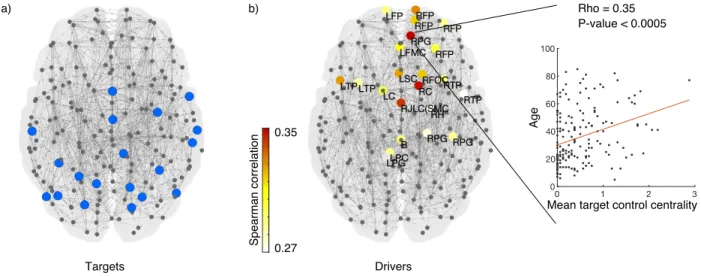HAL Id: hal-03022301
https://hal.inria.fr/hal-03022301
Submitted on 24 Nov 2020
HAL is a multi-disciplinary open access
archive for the deposit and dissemination of
sci-entific research documents, whether they are
pub-lished or not. The documents may come from
teaching and research institutions in France or
abroad, or from public or private research centers.
L’archive ouverte pluridisciplinaire HAL, est
destinée au dépôt et à la diffusion de documents
scientifiques de niveau recherche, publiés ou non,
émanant des établissements d’enseignement et de
recherche français ou étrangers, des laboratoires
publics ou privés.
A step-wise criterion to determine target control
centrality in the aging brain network
Giulia Bassignana, Olivier Colliot, Fabrizio de Vico Fallani
To cite this version:
Giulia Bassignana, Olivier Colliot, Fabrizio de Vico Fallani. A step-wise criterion to determine target
control centrality in the aging brain network. NetSci 2020 - International School and Conference on
Network Science, Sep 2020, Rome / Virtual, Italy. �hal-03022301�
A step-wise criterion to determine target control centrality in the aging brain network
Giulia Bassignana1,2, Olivier Colliot1,2, and Fabrizio De Vico Fallani1,2
1. Sorbonne Universites, UPMC Univ Paris 06, Inserm U-1127, CNRS UMR-7225, Institut du Cerveau et de la Moelle Epini`ere, Hopital Piti´e-Salpˆetri`ere, Paris, France
2. Inria Paris, Aramis project-team, Paris, France
Identifying the nodes that may be able to impact the state of a network is a crucial question for many complex interconnected systems. Because even in relatively small networks there exists a huge number of equivalent controllable walks, the enumeration of all driver nodes is still difficult in practice because of the combinatorial and numerical complexity. In many biological applications it is often possible to only act on single driver nodes and desirable to focus on their ability to control a target node-set of the network [1]. Taking into account these constraints, we propose an optimized heuristic that quantifies the centrality τ of a driver node as the number of targets it can control. Based on the Kalman rank condition, our criterion introduces a hierarchy in the target set and performs a step-wise search. We first validate the method on simple directed networks, finding that the step-wise approach can provide a driver-target configuration in a reduced space-time complexity compared to standard approaches.
We then apply the step-wise target controllability framework to human connectomes obtained from 171 healthy subjects aged from 5 to 85 [2]. We use diffusion tensor imaging and functional magnetic resonance imaging (fMRI) to derive, respectively, structural and functional brain networks with average node degree k varying from 1 to 16. We study a diffusion process on the structural connectome with adjacency matrix A, with the aim to direct it by means of the transition probability Ai, j
∑jAi j. To derive
sparse directed networks, we maintained for each pair of nodes the edge with the highest transition probability. In the case of same value, we keep both edges. Finally, we binarize the resulting adjacency matrix. We study a linear time-invariant dynamics
˙
x(t) = Ax(t) + Bu(t), where x(t) is the state of the network, given by the fMRI values, B and u(t) describe the external input. We choose and rank the target nodes as those brain areas that are more active in the functional connectome, i.e. those corresponding to the 10% highest group-averaged node strength values. We compute the τ values for the subjects in each brain region, averaged at the varying of mean node degree k of the connectomes. Results show that while the target areas tend to belong to parietal and occipital brain areas, driver nodes tend to be in the frontal brain regions (Fig 1a and 1b). Interestingly, we find that their target control centrality tends to be positively correlated with the age of subjects, suggesting that their driving potential is reinforced with normal aging (Fig 1b).
Our work is a preliminary step towards a practical solution to identify controllable driver-target configurations in a complex network and study their importance from a functional perspective.
Figure 1: a) Target brain areas, corresponding to the 10% highest group-averaged node strength values. b) Significant (p < 0.0005) Spearman correlation between age and mean target control centrality, computed on directed structural connectomes with average mean degree k ranging from 1 to 16. The detail shows a scatter plot for the region with the strongest correlation.
[1] Liu Y-Y, Slotine J-J, Barab´asi A-L. PLOS ONE. 2012 Sep 27;7(9):e44459. [2] Brown JA, Van Horn JD. 2016. NeuroImage 124, 1238–1241.
